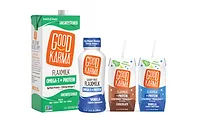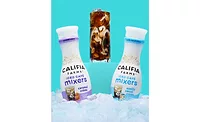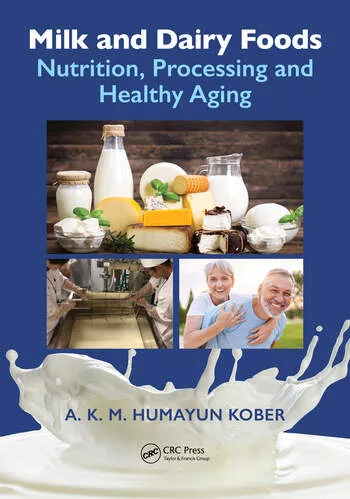Dairy Innovations
Dairy Innovations
By Lori Dahm and Elizabeth Fuhrman
Probiotics, prebiotics and whey are making dairy-based drinks leaders in healthy formulations
Many innovative new dairy-based drinks introduced this year were possible because of the latest ingredient technologies — for example, the big news in drinkable yogurts was the addition of probiotic and prebiotic cultures in nutritional beverages. The drive toward healthier beverages and foods has led to the advance of whey protein in beverages, and the use of new ingredients in dairy applications continues to revolutionize beverages.
Going ‘pro’
The inclusion of probiotic cultures in dairy drinks
finally is hitting its stride, after five to 10 years of experts positing
that consumers were ready to embrace the probiotic concept. As defined by
the World Health Organization, probiotics are live microorganisms, which
when administered in adequate amounts confer a health benefit.
“The most essential traits of probiotics are
their ability to resist stomach acid, bile salts and digestive enzymes;
their ability to adhere to intestinal mucosa and cohabit with indigenous
intestinal microflora, or to produce substances that suppress the growth of
undesirable bacteria without damaging the endogenous intestinal
flora,” says Mirjana Curic-Bawden, senior scientist at Chr. Hansen,
Milwaukee.
Probiotic cultures have been a part of dairy products
in other countries for decades. Kefirs and fermented dairy beverages on the
market in Europe and Asia have traditionally included live and active
cultures, and consumers there are familiar with the health benefits that
probiotic cultures confer, such as gut health, immunity and other
attributes.
“We are observing trends in products in the
United States that are just the tip of the iceberg of the popularity that
similar products have received in Europe and Asia for the past two
decades,” Curic-Bawden says.
New products are appearing in the global market, and
signs indicate that these products soon will make an appearance in
the United States. “A range of new dairy-based products was recently
launched in Europe and Asia, fermented whey or fermented skim milks blended
with orange juice or fruit cocktails,” Curic-Bawden says.
“These types of products are very innovative; they are usually
formulated to deliver combined health benefits of whey proteins,
probiotics, vitamins and very often prebiotic
fibers or phytonutrients and antioxidants.”
For the present status of probiotics on this
continent, use of live and active cultures is appearing primarily in
yogurt-type products, which are particularly suitable for probiotics
because of the other cultures within the yogurt formulation.
“One reason that yogurt and fermented milk
products are almost always considered traditional carriers of probiotics is
because some probiotic strains (most of them belonging to lactic acid
bacteria) can grow to a certain extent during the incubation of
milk,” Curic-Bawden says. “... In any case, it is of utmost
importance that the probiotic strains survive during the shelf life, but do
not have a negative effect on the taste of the final product.”
It is this survival through the shelf life of a
product that is particularly important in the field of probiotic-laden
products. To deliver a beneficial effect, probiotics must be ingested in
adequate amounts, which generally are considered a minimum of 100 million
live and active probiotic cells per serving, although the trend is now
moving toward an even higher count.
“Achieving a high count in a freshly fermented
product is almost always a matter of inoculation rate and growth
(incubation) conditions,” Curic-Bawden says. “Keeping the high
cell count for 50 to 60 days, which is now tending to be a standard shelf
life of fermented milk in the United States, depends on numerous factors
such as the pH of the product, the presence of dissolved oxygen, the
addition of various preservatives and storage temperature.”
‘Pre’ trends
While probiotic products are receiving a lot of the
attention lately, developers are seeking more ways to differentiate their
products, and prebiotic cultures could be the next level of gut-health
products.
Prebiotics are non-digestible fibers that pass through
the stomach to help stimulate the activity of bacteria in the colon.
Prebiotics also have been shown to increase calcium absorption when
incorporated as ingredients in certain dairy products. Prebiotics are
naturally present in low concentrations in foods such as garlic, onion,
artichoke and chicory root, and more concentrated industrial ingredients
typically are produced through hot-water extraction from the chicory root.
Stimulating the growth and activity of beneficial
intestinal flora appears to be what will attract beverage-makers. Profile
GOS from Kerry Dairy Ingredients, based in Ireland, acts as a prebiotic
soluble fiber, and reaches the colon fully intact where it is then
fermented by colonic micro flora. GOS is a galacto-oligosaccharide enriched
whey powder derived from bovine milk lactose. The lactose is enzymatically
broken down into galactose and glucose and subsequently polymerised into
galacto-oligosaccharides.
“The primary benefits associated with the growth
of beneficial bacteria and reduction of pathogens is the decrease in the
incidence of diarrhea as well as increased mineral absorption,” says
Margaret Greaney, marketing services manager for Kerry Ingredients.
“Further studies also propose its beneficial role in reducing
cholesterol levels and prevention of colon cancer.”
Galacto-oligosaccharides in GOS are heat and acid
stable, with little, if any, losses during pasteurization, making the
cultures suitable for many beverages. Galacto-oligosaccharides also occur
naturally in human breast milk, hence prebiotics can be applied to infant
and medical nutrition products as well as fermented dairy and nutritional
beverage applications.
Trends such as rising obesity levels, an aging
population, specific dietary requirements, and a general trend toward
healthy lifestyles are pushing the popularity of prebiotics.
“These trends are significant and have been
driving the development of more varied, tasty, functional, convenient and
nutritious food and beverage products,” Greaney says. “It is
important to note that this is not just within specialist nutrition markets
but right across the food and beverage spectrum. Prebiotics meet a number
of these demands and are as applicable in specialist nutrition sectors as
mass market produce.”
Whey in
Whey as an ingredient is making a showing in many new
nutritional beverages, such as isotonics, energy drinks, enhanced waters
and juices, as a protein source. Whey is
expected to expand into ready-to-drink teas and carbonated soft drinks too.
This is no small wonder, considering that the most
recent studies reveal that whey protein has significant power and potential
for its healthy attributes. Dairy Management Inc., Rosemont, Ill., hosted a
Whey Symposium at this year’s IFT Annual Meeting — titled
“Whey Protein: Physiological Effects and Emerging Health
Benefits” — that presented several new studies conducted with
whey with regard to muscle synthesis, weight management and satiety, and
even some preliminary anti-carcinogen studies.
“Research reported by Stuart Phillips at
McMaster University in Hamilton, Ontario, showed that milk protein
administered after exercise revealed that the combination of whey protein
with casein has a positive synergistic effect on muscle protein synthesis
and retention. The amino acids from whey and from casein both are
responsible for milk protein being more effective in muscle recovery than
other proteins,” says Pete Huth, director of regulatory and research
transfer at DMI. “Whey protein is a fast absorbing protein so its
amino acids are rapidly absorbed into the bloodstream and reach the muscle
tissue quickly to stimulate protein synthesis, whereas casein is a slower
absorbing protein that has been shown to suppress the normal process of
muscle protein breakdown.”
Phillips’s research shows that these two dairy
proteins have a complementary effect of promoting muscle protein
development leading to building body muscle.
Whey was once the ugly stepchild of cheese, a
byproduct that was a concern to manufacturers only because of the need for
its disposal. Whey protein is one of the highest-grade proteins available
in the food industry. The amino acid profile of whey is almost identical to
that of skeletal muscle, and whey protein supplements generally provide a
higher dose of the essential amino acids than other protein sources.
Whey protein isolate is an excellent quality protein,
scoring high marks in all measures of protein quality, says Kelly
Czerwonka, marketing manager at Glanbia, Monroe, Wis. “Whey protein
also has the highest level of branched chain amino acids (leucine,
isoleucine and valine) for muscle development and maintenance,” she
explains. This makes it particularly popular among body builders.
Although whey ingredients have been documented to have
substantial health benefits in the realm of weight management, lean muscle
mass maintenance, anti-hypertension and even some positive blood lipid
effects, whey’s presence within actual retail products has not
reached anywhere near its full potential.
“Whey protein is an ideal ingredient for use in
many drinks that could boast health benefits, because whey protein is easy
to use, can be used in clear drinks at low pH, and is relatively free of
taste,” says K.J. Burrington, dairy ingredients applications program
director at the University of Wisconsin Center for Dairy Research, Madison.
“Right now the mainstream market products that include whey are
primarily the yogurt drinks or the smoothie drinks that include whey
protein for its enhanced protein boost. There are a number of drinks
designed for body builders and weight lifters with up to 40 grams of whey
protein per serving, but these are generally sold in health stores.”
Beverages are considered a ripe opportunity for using
whey protein ingredients to create products that offer health benefits.
“Beverages are definitely a key delivery system
for whey protein. Whey protein isolate and whey protein concentrate are
used in a range of beverages, including dry blended — primarily
sports and weight-loss drinks — and ready-to-drink smoothies,
milk-based beverages, clear sports beverages, juice-based drinks, clinical
nutrition drinks and more,” Czerwonka says. “Driving whey
protein’s use in beverages is the growth of the functional beverages
category, which continues to grow as people become increasingly health
conscious.”
Whey proteins are ideal for their nutritional punch in
sports beverages because whey ingredients can be used in clear beverages
with a pH from 3 to 4.5, offering high solubility. “Where the
functionality and performance of whey proteins really stand out in the
beverage arena is in drinks with a lower pH range, because the whey
proteins are exceptionally clear so many beverage applications could
include them,” Burrington says. “The only consideration for
using whey in these applications would be if the product is to be heat
treated, and ensuring that the whey ingredient is pre-hydrated
sufficiently.”
Pre-hydration is important so the protein can
stabilize in water and thereby be protected if the product is then
heat-processed.
And there are applications in which whey proteins need
stabilizer systems in order to remain in solution. For example, if the pH
of the beverage environment is higher than 4.5, than the isoelectric point
of the whey changes and stabilizers such as pectin are often needed to keep
the whey proteins from aggregating.
Whey protein has been avoided in ready-to-drink
beverages up to now due to the binding characteristics produced when heat
was applied for retort of UHT processing, says Laura Majors, marketing
services manager for Leprino Foods in Denver. “New innovations in the
processing of whey protein have made it possible to customize the protein
for a wide range of functional characteristics, including liquid
applications such as UHT and retort ready-to-drink beverages,” Major
says.
Whey is only at the beginning of its use in beverages,
she emphasizes. “The consumer market is demanding new convenience
products, and want the flavor and texture while they receive nutrition. The
market wants to believe they are breaking nutritional rules with flavor
while they are actually delivering the best nutrition to their body.”
Lori Dahm is technical editor for Dairy Field. Portions of the article
were excerpted from Dairy Field’s State of the Industry report. For more information on dairy
ingredients and the full report, visit dairyfield.com.
Better, longer flavor for dairy
Wild Flavors, Erlanger,
Ky., developed a LightShield Technology based on a blend of ingredients
that minimize light-activated reactions — reducing the development of
light-activated flavors (LAF) — in dairy-based items. LAFs occur due
to exposure to ultraviolet and fluorescent lights found in grocery display
cases. LightShield Technology allows processors to extend flavor shelf life
in milk-based and dairy-based products, while providing the customer more
variety in packaging options. LightShield's powder is water-soluble,
heat-stable, and effective in both high- and low-acid products. The system
does not contribute flavor or alter end-product attributes such as texture.
The LightShield Technology entails a blend of
components for specific dairy products including smoothies, fluid milk,
flavored milk, and milk and juice beverages. In a study involving a dairy
and juice drink, unacceptable notes were detected after about one week in
the control, while the sample made with LightShield Technology was still
satisfactory at 60 days, the company says.
Looking for a reprint of this article?
From high-res PDFs to custom plaques, order your copy today!





